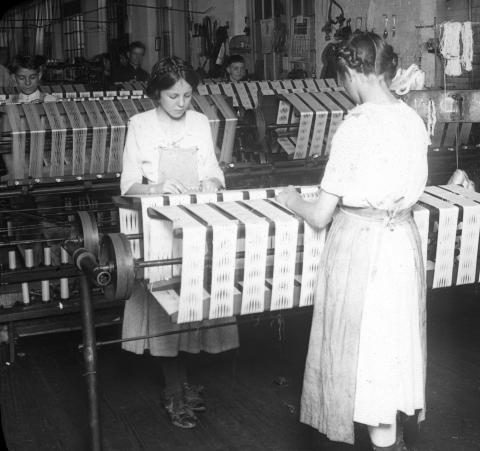
Today's #WorkerWednesday has us visiting workers in a silk mill in Patterson, New Jersey. Patterson emerged in the 1790s as an industrial power, thanks to the Passaic River Gorge, which provided water power for a variety of industries. Manufacturers began producing silk in the city in the 1840s, and the industry boomed after the Civil War when higher tariff costs on imported silk made domestic manufactures more appealing to American consumers. By the 1880s, Patterson was the nation's "Silk City", producing nearly half of the silk manufactured in the United States.
Beginning in February 1013, the city was also home to one of the many industrial conflicts that had begun upending the garment and textile industries in the United States since the New York shirtwaist strike of 1909. That month, workers like the ones seen here joined with twenty-five thousand of their colleagues in the city's silk, ribbon, and dye industries to protest the efforts of silk mill owners to increase workloads on weavers; upping loom assignments from two looms per worker to four. Striking workers also complained of years of declining wages and working conditions and demanded shorter work days and a set minimum wage for labor.
The strike, the biggest in the city's history, united skilled and unskilled workers across gender and ethnic divides and attracted the involvement of the international labor union Industrial Workers of the World. By the end of the strike in July of 1913, 1,850 strikers had been arrested and two people had been killed; Valentino Modestino, a bystander to the strike was fatally shot by a private guard, and Vincenzo Madonna, a striking worker was fatally shot by a strikebreaker. The strikers had also exhausted their resources, and were forced to return to the mills.
The workers gained some power from the standoff; during labor conflicts in 1916 and 1919, Patterson silk mills owners made significant concessions rather than risk a second strike, and two loom assignments remained the standard in the city even as mills nationwide assigned weavers to four looms at a time. But those who could afford to do so also left the city rather than continue to concede to worker demands; by 1923, the medium and large sized mills of "Silk City" had largely left town.
This early 1900s photograph was taken by the New York City firm of Underwood & Underwood, a popular publisher of stereoviews that pivoted to the emerging field of news bureau photography during the early 20th century. A caption associated with the image reads "Reeling and lacing silk, preparing skeins for weavers". It is part of Hagley Library's collection of Lantern slides on coal mining, railroads, oil wells, sugar refining, steel mills, glass manufacturing, silk manufacturing, Atlantic City, NJ (Accession 1974.375).

